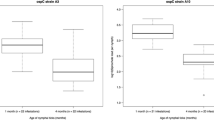Abstract
To more closely define the risk of infection by the agent of Lyme disease in Europe, we determined whether spirochetal prevalence increases throughout the development of theIxodes ricinus vector tick. Of all ticks that could be flagged from vegetation,I. ricinus were by far the most abundant. Spirochetal infection rates in the adult stage of this tick (15%) are no higher than those in nymphs (18%) but greatly exceed those in larvae (0.7%). This tick therefore appears to attain infection mainly from the host of its larval stage, generally feeds on hosts that are noncompetent as reservoirs in its nymphal stage, and rarely inherits infection. Risk of human infection mainly derives from contact with the nymphal stage of the vector tick because the larva is rarely infected and the adult is large enough to be noticed and promptly removed.
Similar content being viewed by others
References
Aeschlimann A, Chamot E, Gigon F, Jeanneret JP, Kesseler D, Walther C (1986)B. burgdorferi in Switzerland. Zentralbl Bakteriol Mikrobiol Hyg [A] 263:450–458
Anderson JF, Doby JM, Coutarmanac'h A, Hyde FW, Johnson RC (1986) Différences antigéniques entre des souches deBorrelia burgdorferi isolées d'Ixodes ricinus en Bretagne. Med Malad Infect 3:171–175
Burgdorfer W, Barbour AG, Hayes SF, Péter O, Aeschlimann A (1983) Erythema chronicum migrans — a tick-borne spirochetosis. Acta Trop (Basel) 40:79–83
Hubálek Z, Halouzka J, Juricová Z (1991) A comparison of the occurrence ofBorreliae in nymphal and adultIxodes ricinus ticks. Zentralbl Bakteriol Mikrobiol Hyg [A] 275:133–137
Kahl O, Schmidt K, Schönberg A, Laukamm-Josten U, Knülle W, Bienzle U (1989) Prevalence ofBorrelia burgdorferi inIxodes ricinus ticks in Berlin (West). Zentralbl Bakteriol Mikrobiol Hyg [A] 270:434–440
Lane RS, Burgdorfer W (1987) Transovarial and transstadial passage ofBorrelia burgdorferi in the western black-legged tick,Ixodes pacificus (Acari: Ixodidae). Am J Trop Med Hyg 37:188–192
Magnarelli LA, Anderson JF, Fish D (1987) Transovarial transmission ofBorrelia burgdorferi inIxodes dammini (Acari: Ixodidae). J Infect Dis 156:234–236
Matuschka FR, Spielman A (1992) Loss of Lyme disease spirochetes fromIxodes ricinus ticks feeding on European blackbirds. Exp Parasitol 74:151–158
Matuschka FR, Lange R, Spielman A, Richter D, Fischer P (1990) SubadultIxodes ricinus (Acari: Ixodidae) on rodents in Berlin, West Germany. J Med Entomol 27:385–390
Matuschka FR, Fischer P, Musgrave K, Richter D, Spielman A (1991) Hosts on which nymphalIxodes ricinus most abundantly feed. Am J Trop Med Hyg 44:100–107
Matuschka FR, Fischer P, Heiler M, Richter D, Spielman A (1992) Capacity of European animals as reservoir hosts for the Lyme disease spirochete. J Infect Dis 165:479–483
Piesman J, Donahue JG, Mather TN, Spielman A (1986a) Transovarially acquired Lyme disease spirochetes (Borrelia burgdorferi) in field-collected larvalIxodes dammini (Acari: Ixodidae). J Med Entomol 23:219
Piesman J, Mather TN, Donahue JG, Levine J, Campbell JD, Karakashian SJ, Spielman A (1986b)Comparative prevalence ofBabesia microti andBorrelia burgdorferi in four populations ofIxodes dammini in eastern Massachusetts. Acta Trop (Basel) 43:263–270
Piesman J, Mather TN, Dammin GJ, Telford SR, Lastavica CC, Spielman A (1987) Seasonal variation of transmission risk of Lyme disease and human babesiosis. Am J Epidemiol 126:1187–1189
Stanek G, Burger I, Hirschl A, Wewalka G, Radda A (1986)Borrelia transfer by ticks during their life cycle. Zentralbl Bakteriol Mikrobiol Hyg [A] 263:29–33
Wilske B, Steinhuber R, Bergmeister H, Fingerle V, Schierz G, Preac-Mursic V, Vanek E, Lorbeer B (1987) Lyme-Borreliose in Süddeutschland. Dtsch Med Wochenschr 112:1730–1736
Zung JL, Lewengrub S, Rudzinska MA, Spielman A, Telford SR, Piesman J (1989) Fine structural evidence for the penetration of the Lyme disease spirocheteBorrelia burgdorferi through the gut and salivary tissues ofIxodes dammini. Can J Zool 67:1737–1748
Author information
Authors and Affiliations
Additional information
This work was supported in part by grant AI 19693 from the National Institute of Allergy and Infectious Disease and by grants from the city of Berlin
Rights and permissions
About this article
Cite this article
Matuschka, FR., Fischer, P., Heiler, M. et al. Stage-associated risk of transmission of the lyme disease spirochete by EuropeanIxodes ticks. Parasitol Res 78, 695–698 (1992). https://doi.org/10.1007/BF00931523
Accepted:
Issue Date:
DOI: https://doi.org/10.1007/BF00931523




